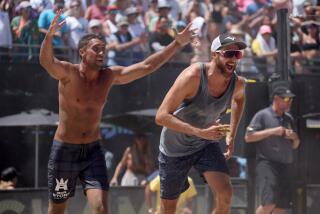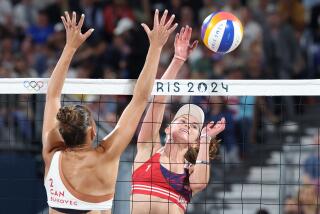A Four-Man Format for Beach Volleyball
- Share via
SAN DIEGO — Craig Buck wasn’t a sand rat, so he never got into two-man beach volleyball.
As the middle blocker on the U.S. national volleyball team for most of the 1980s, he didn’t have time to play the traditional beach game.
“I’ve been an indoor player my whole career, so I typically was busy all summer,” Buck said. “My position is physically demanding. I have to jump every single play, so I would jump three or four times as much as any other player in practice.
“So, come weekends, I wasn’t interested in running to the beach.”
Buck and others who never were attracted to the sand for one reason or another are about to become beach players. Buck is the captain of one of five four-man teams on the new Michelob Light Volleyball Tour.
The first tournament is at Pacific Beach here Saturday and Sunday. The tour continues at Phoenix, June 8-9; Cleveland, June 15-16; Boston, June 22-23; Ft. Myers, Fla., July 13-14; Clearwater, Fla., July 20-21; and Myrtle Beach, S.C., July 27-28.
Each of the first six tournaments has a $28,000 purse; the final has a $37,352 purse. All seven tournaments will be televised on ESPN on a delayed basis.
The four-man format will combine the action and strategy of the six-man indoor game and the casual yet competitive beach atmosphere.
The tournaments will be round-robin rather than double-elimination. The winner of the round-robin competition advances to the the finals, while the next two teams play for the other spot in the finals. The finals will be one game to 15.
“The idea is to improve on the two-man game,” said Buck, who was on the U.S. teams that won gold medals at the 1984 and 1988 Olympics. “It’s a little bit better. Simply, there’s more rallies, more to watch. The sophistication increases, there’s more offense and there’s more communication, which is entertaining.
“At practice, I had a blast. It’s not that easy to put the ball away. We had a couple of rallies that lasted five minutes. In two-man, you just hit to the open court. But in this game, there is no open court.”
Buck is a middle blocker for a big reason -- at 6-foot-8, 203 pounds, he’s one of the biggest volleyball players in the world.
“Two-man doesn’t fit my game,” Buck said. “I’m tall; my specialty is middle blocking. I have a defensive setter and the two others are passers. We all have our specialties.”
Craig Elledge, president of the American Beach Volleyball League, has switched to backing the four-man game after promoting two-man tournaments for the Association of Volleyball Professionals.
“What really makes this work is the availability of quality players,” Elledge said.
“The two-man game requires all-around skill acquired by growing up on a beach. Guys like Craig Buck, Bob Ctvrtlik and Jeff Stork, all Olympic gold medalists, aren’t making a nickel on the two-man tour because they don’t possess all-around skills. They’re more skill-position players.
“This is a format that provides these guys making a lot of money in Europe in the winter a chance to play on the beaches in summer and make some money, albiet in a format they can be competitive in.
“The other reason was I was real tired of watching two-man volleyball. After (promoting) 130 tournaments on the two-man tour, I just felt that it was a sideout, sideout game. There’s got to be more.”
The other team captains are Ctvrtlik, Stork, Doug Partie and Gary Sato. Ctvrtlik, Partie and Stork all played on the ’88 U.S. Olympic team; Sato was an assistant coach. All five team captains were college All-Americans, as were most of the other players.
The league set up a draft, and the five captains picked three active players and two reserves.
“We wanted parity,” Elledge said. “We didn’t want to have another Smith-Stoklos scenario.” Sinjin Smith and Randy Stoklos have dominated the two-man game.
“The only thing I’m disappointed in is no $3 million signing bonuses,” Buck joked.
After the third and sixth tournaments, each captain has the option of placing any player on waivers, and either bringing up a player not on his active roster or requesting a player from another team’s inactive roster. Teams can also make straight-up trades, captains excluded.
Buck, of Carlsbad, chose Troy Tanner, an ’88 Olympian, and Steve Rottman and Jim Nichols, both former AVP players.
The beach won’t be the end of the road for Buck, who said he wants to try out for the Olympic team next year, when he will be 33.
“My first priority is to play in ‘92,” Buck said. “Olympic volleyball is the best volleyball. I doubt that I’ll do much after ’92. My body hurts and I’ve had a lot of surgery. I hope I can survive until ’92. That’s why I drafted who I drafted.”
More to Read
Go beyond the scoreboard
Get the latest on L.A.'s teams in the daily Sports Report newsletter.
You may occasionally receive promotional content from the Los Angeles Times.






